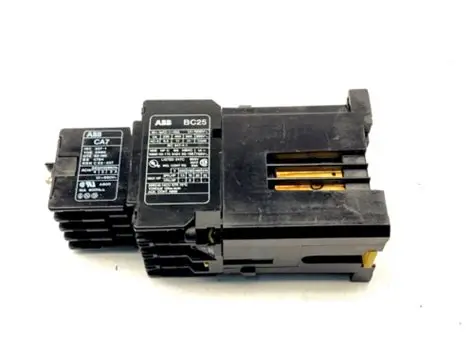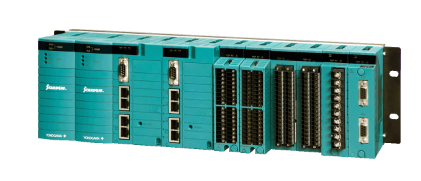The ABB BC25 controller module is a compact control unit designed for small and medium-sized industrial automation control scenarios, and is an important component of ABB's distributed control system (DCS). It mainly undertakes the tasks of logical control of local equipment, data acquisition and processing, and communication with higher-level control systems. It is widely applicable to small and medium-sized production facilities in industries such as chemical, power, and water treatment, and is a key component for achieving local production process automation and improving equipment operation stability.
ABB BC25 Controller Module
Product core positioning
Official definition: The ABB BC25 controller module is a compact control unit designed for small and medium-sized industrial automation control scenarios, and is an important component of ABB's distributed control system (DCS). It mainly undertakes the tasks of logical control of local equipment, data acquisition and processing, and communication with higher-level control systems. It is widely applicable to small and medium-sized production facilities in industries such as chemical, power, and water treatment, and is a key component for achieving local production process automation and improving equipment operation stability.
Four core functions
Logic Control and Program Execution
Built in high-performance microprocessor, supporting multiple programming languages such as ladder diagram (LD), functional block diagram (FBD), structured text (ST), etc. It can write complex control programs according to production needs, realizing logical operations such as start stop, speed adjustment, switch control, etc. for valves, pumps, motors, and other equipment. For example, in the ingredient production process of chemical engineering, the opening and closing time of each raw material valve can be precisely controlled according to the preset formula to ensure accurate ingredient ratios.
Data collection and real-time processing
Equipped with multiple analog and digital input interfaces, it can real-time collect key process parameters such as temperature, pressure, flow rate, liquid level, as well as equipment operating status signals (such as motor operating current, valve switch status) during the production process. By using built-in data processing algorithms to filter, convert, and analyze the collected data, the processed data is uploaded in real-time to the higher-level control system, while storing key historical data, providing a basis for production optimization and fault tracing.
Equipment status monitoring and alarm
Real time monitoring of the operating parameters of the controlled equipment and the working status of its own modules. When parameters exceed preset thresholds (such as high temperature, abnormal pressure) or module failures (such as communication interruption, power supply abnormality) are detected, local sound and light alarms are immediately triggered, and the alarm information is sent to the higher-level monitoring system and operator terminals through the communication interface. At the same time, automatic recording of alarm time, alarm type, and related parameters facilitates technicians to quickly locate the fault point and shorten the fault handling time.
Multi system communication and collaboration
Supports multiple industrial communication protocols, including Modbus RTU, Profinet, EtherNet/IP, etc., and can communicate with higher-level DCS systems PLC、 The human-machine interface (HMI) and on-site intelligent instruments achieve seamless communication. It can not only receive control instructions issued by the higher-level system, but also provide real-time data and equipment status feedback collected locally to the higher-level system, achieving information sharing and collaborative control of the entire production system. For example, in a water treatment plant, it can communicate with the central control system of the plant, receive water quality indicator control instructions, and upload operational data of each treatment unit to ensure efficient collaboration throughout the entire water treatment process.
Key technical characteristics
Model identification
BC25
Representing a specific model in ABB's compact controller series, it features high cost-effectiveness and compact design
Product type
Industrial controller module
Compact control unit integrating logic control, data acquisition, and communication functions
Applicable system
ABB Distributed Control System (DCS) and Small and Medium sized Industrial Automation Systems
Compatible with ABB AC 800M, AC 500 and other series control systems, and can also be used independently for small control scenarios
Input/output interface
16 digital inputs (DI), 12 digital outputs (DO), 8 analog inputs (AI), 4 analog outputs (AO)
Can meet the signal acquisition and control needs of small and medium-sized production equipment, and support increasing the number of interfaces through expansion modules
Working voltage
DC 24V ±15%
Adapt to voltage fluctuations in industrial sites and have overvoltage, undervoltage, and short-circuit protection functions
Working temperature range
-20℃~60℃
Can operate stably in harsh industrial environments with high and low temperatures, suitable for outdoor or complex production scenarios
Communication speed
Up to 100Mbps (EtherNet/IP protocol)
Ensure real-time and reliable data transmission to meet the communication needs of small and medium-sized production systems
Program storage capacity
128KB
Can store multiple sets of complex control programs, supporting online modification and download of programs
Data storage capacity
512KB
Capable of storing a large amount of historical data, and the storage period can be flexibly set according to needs
Installation and maintenance specifications
1. Installation process
Preparation work: Disconnect the power supply of relevant equipment, wear anti-static gloves and wristbands to avoid static electricity damaging the module; Clean the dust and debris from the installation location, and check if the installation bracket is secure; Check whether the module model and specifications are consistent with the design requirements, inspect the appearance of the module for scratches and damage, and ensure that the interfaces are intact.
Installation operation: Place the module steadily on the installation bracket, fix it with special screws, and ensure that the module is installed firmly and without looseness; Connect power lines, input/output signal lines, and communication lines according to the wiring diagram. When wiring, pay attention to distinguishing positive and negative poles and signal types to avoid misconnection; After completing the wiring, organize the circuit and fix it with wire clips to prevent the wiring from being messy and affecting subsequent maintenance or loosening due to vibration.
Verification check: Connect the power supply and observe the status of the module indicator light. Under normal circumstances, the power indicator light should be constantly on, and the fault alarm light should be on if there is no fault; Connect the module through programming software, check if the module can be recognized normally, upload the preset control program and conduct simulation testing to verify whether the input and output signals respond normally and whether communication is smooth; Simulate a fault scenario (such as disconnecting an input signal) and check if the alarm function is triggered normally.
2. Maintenance points
Daily inspection: Conduct a weekly inspection of the module to check for any damage to its appearance and whether the indicator lights are in normal condition; Check whether the wiring terminals are loose or oxidized, and if so, tighten or clean them in a timely manner; Check the operating parameters of the module through the upper computer and confirm that all parameters are within the normal range.
Cleaning and maintenance: Clean the module every two months, gently blow away the dust on the surface and interface of the module with dry compressed air, to avoid dust accumulation affecting heat dissipation or causing poor contact; If the module is installed in a dusty and humid environment, the cleaning frequency should be increased. When cleaning, the power should be disconnected, and it is forbidden to wipe the module directly with water or cleaning agents.
Fault handling: When a module generates a fault alarm, first check the alarm code and fault prompt information, read the fault log through programming software, and preliminarily determine the cause of the fault; If it is a wiring problem, disconnect the power and recheck and tighten the wiring; If it is a program issue, backup the current program and re upload the correct program; If there is suspicion of a hardware failure in the module, it is necessary to replace the backup module and send the faulty module to a professional organization for repair. Before replacement, the parameter settings of the module should be recorded to ensure that the parameters of the backup module are consistent with those of the original module.
Software maintenance: Regularly check whether the control program has vulnerabilities or optimization space, and update the program in a timely manner according to production process adjustments; Regularly upgrade module firmware, and backup the original firmware and programs before upgrading to avoid data loss or module malfunction caused by upgrade failure.
Common application scenarios
Chemical industry: In small and medium-sized chemical plants (such as small reactors and solvent recovery units), it is used to control parameters such as reaction temperature, pressure, and flow rate, achieve automated control of raw material feeding, reaction process, and product discharge, and monitor equipment operation status to ensure production safety and stability.
In the power industry, responsible for monitoring transformer temperature, voltage, and current in small substations and distributed photovoltaic power stations, controlling the opening and closing operations of circuit breakers and isolating switches, communicating with the grid dispatch system, uploading power station operation data, receiving dispatch instructions, and achieving automated operation and remote monitoring of the power station.
Water treatment industry: In small-scale sewage treatment plants and industrial wastewater treatment facilities, the operation of equipment such as water pumps, aeration fans, and dosing pumps is controlled. The dosage and aeration intensity are automatically adjusted based on water quality testing data to achieve automated control of the sewage treatment process and ensure that the effluent quality meets the standards.
Food processing industry: In small and medium-sized food production lines (such as beverage filling lines and pastry baking lines), control parameters such as conveyor belt speed, heating temperature, and filling volume to achieve precise control of each link in food processing. At the same time, monitor equipment operation status to prevent production interruption or product quality problems caused by equipment failures.
Metallurgical industry: In small metallurgical auxiliary equipment (such as small rolling mills and heat treatment furnaces), controlling the operating speed, heating temperature, cooling water flow rate and other parameters of the equipment to achieve automated operation, improve production efficiency and product quality, and reduce manual operation intensity.

- User name Member Level Quantity Specification Purchase Date
- Satisfaction :
-









Email:wang@kongjiangauto.com




































































































































